Top 13 Things to Do in Nikko, Japan: Top Tourist Attractions and Jaw-Dropping Nature Sites

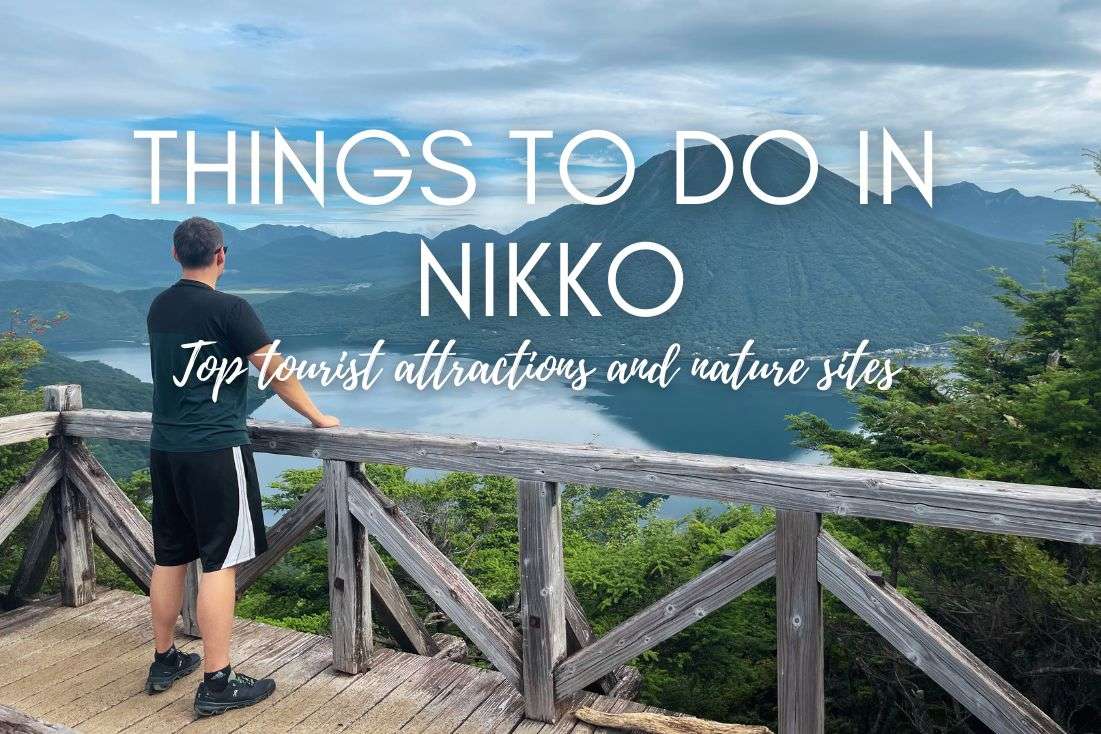
First things first, if you think Nikko is just a sleepy town north of Tokyo, you're in for a shocker—it’s an absolute powerhouse of culture, history, and natural beauty. Let me lay it down for you: Nikko was the first place I visited in Japan, and while it set the bar high, I only realized at the end of my trip that is was my absolute favorite place! Talk about starting out strong.
Don't get me wrong, the restaurants in Nikko are a disaster, which is usually enough to taint a destination for me. But Nikko still managed to pull out on top. Maybe it's the nostalgia talking since it was my first taste of Japan, but this place has a vibe that’s hard to match. When you're talking about a stellar combination of monumental sights and stunning nature—Nikko is unbeatable.
Another peculiar thing about Nikko is that everything feels a bit like a throwback to the '80s and '90s in the USA—super clean, yet unmistakably aged. Despite the crowds, Nikko has an old-world charm which I half-expected to match that which I found in Denmark but didn’t. Nikko’s uniquely its own, and I can appreciate that. After all, I’ve visited a lot of places, and don’t like it when that “been there, done that” feeling creeps in.
My top tips for visiting Nikko
Two important tips for Nikko right off the bat: Bring bug spray because the mosquitoes are no joke, and prepare yourself for the traffic; it's almost as outrageous as the beauty!
Do you need a car in Nikko? Well, you can visit the main sights in town without a car, but if you want to dive deep into those lush natural spots, it would be nearly impossible without one.
It would be insanely hard to reach all those natural places close to Nikko with public transportation, especially in the sweltering, sticky August heat—easy 35°C (95°F) in the shade, folks. Seriously, bring a personal AC unit.
Beware of cash-only parking and have cash on you at all times (which, by the way, is usually super cheap at just JPY 1000 per day). But if you had read my Japan Travel Tips article, you’d know that ultra-futuristic Japan still favors cash over cards, because in reality it’s more like ultra-futuristic 90s Japan.
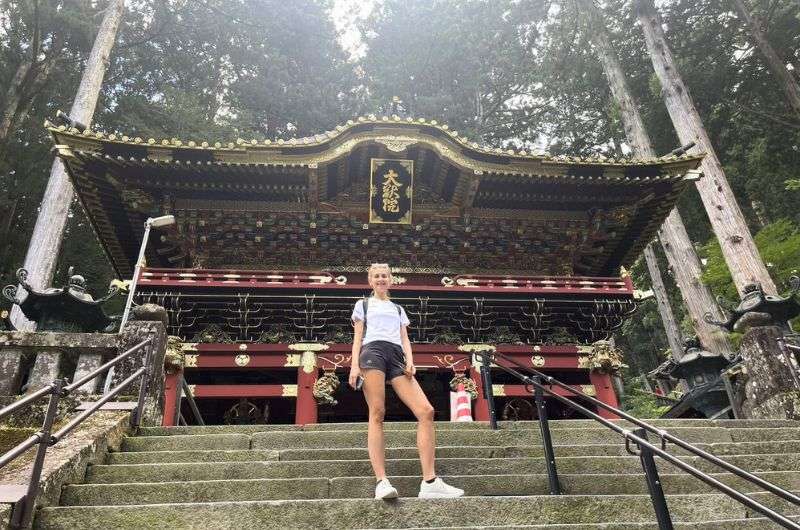
Get ready to walk up and down a lot of stairs at the shrines in Nikko!
List of things to do in Nikko
Here's a list of all the things to do in Nikko we’re about to cover in this article:
- Lake Chuzenji & Hangetsuyama Hike
- Kegon Falls
- Toshogu Shrine
- Lake Yunoko & Yudaki Falls
- Rin’nōji Taiyū-in Mausoleum
- Nikkozan Rin’nōji Temple
- Ryuzyu Falls
- Nikko Futarasan Shrine
- Senjōgahara Grassy Plains
- Imperial Villa of Nikko
- Italian and British Embassy Villas
- Shinkyo Bridge
- Nikko Treasure House
Map of Nikko’s best places
All the blue dots show where Nikko’s top attractions are. You can go to my Google Maps list that includes all of these and save it for yourself to use during your trip
The best hotel in Nikko: The Fairfield by Marriott Nikko
And before we start, you might be wondering where we stayed in Nikko. The Fairfield by Marriott—despite being a tad pricey (but that is standard in Japan), is literally the perfect hotel to explore the Nikko area. A free parking lot, close enough to town to walk, big comfy beds, high-tech toilets that'll make you grin (shitting with a smile, now that’s what I call a vacation upgrade!), and customer service so good it feels like they should be running for office. If they were any more helpful, they’d probably tuck you in at night! The Fairfield in Nikko easily snagged the title of my second favorite hotel in Japan (this is my first place winner).
Are you ready to explore the top 13 things to do in Nikko? Let’s roll! We managed to see them all in 2 packed days. Get my Nikko itinerary here to see how to follow in our footsteps.
1. Lake Chuzenji & Hangetsuyama Hike
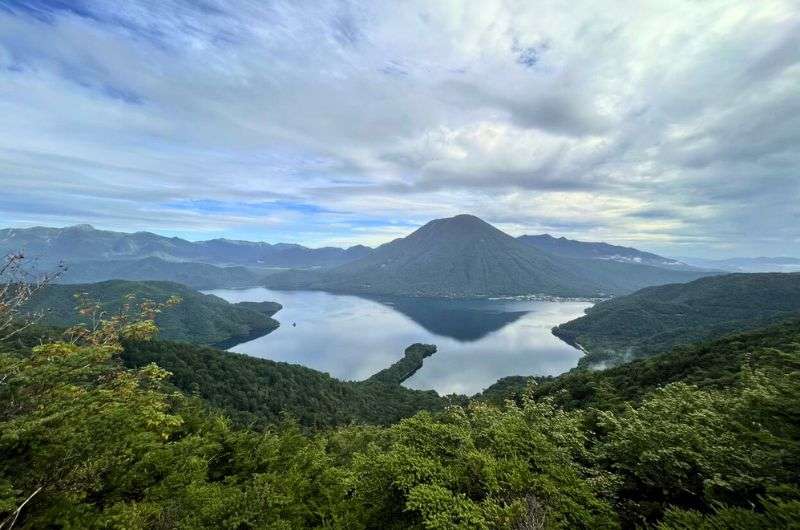
Views of Lake Chuzenji with Mt. Nantai as the backgrop. Not bad!
Guys and gals, if you're into nature that absolutely smacks you in the face with its raw beauty, the top thing to do in Nikko is obviously Lake Chuzenji and the Hangetsuyama hike. Heck, this should be the first place you visit, because you get an overview of the area and sort of a trailer of what’s to come. Most of the other natural highlights of the Nikko region are nearby.
Nestled at a breezy elevation of 1,270 meters (4,160 ft), Lake Chuzenji isn't just any body of water—it's Japan's highest natural lake, the country's answer to Lake Geneva (Switzerland/France) or Italy’s Lago di Garda. Imagine this: a massive volcanic backdrop, Mt. Nantai, towering over you at 2,500 meters (8,200 ft). The drive alone offers killer views that’ll have you pulling over every five seconds to snap a photo.
Lake Chuzenji is also where you’ll find other impressive natural attractions including three of Nikko’s famous waterfalls: Kegon, Ryuzu, and Yudaki. But more about those later.
But let's talk hiking—Hangetsuyama. This isn't your everyday stroll through the park. First, take the scenic drive up to the observatory. The gate opens at 7 am, and being the early bird here means you get the worm—or in this case, the mountain, all to yourself. From the parking at 1,600 meters (5,250 ft), it's about a 30-minute walk to the observatory.
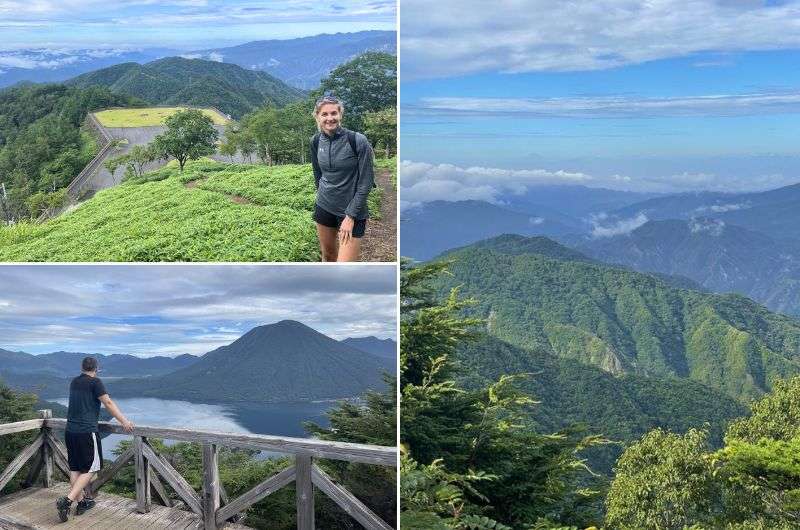
One little hike and look at all those amazing views @ Hangetsuyama hike
The terrain on this short hike is like nature threw a wild party—lush, rugged, and utterly different from the 'Alps' vibe some folks might expect. And keep your eyes peeled for monkeys along the way; those little thieves are as sneaky as can be! These aren’t as tame as those we observed at the hot springs in Nagano, they’re proper little buttholes with a chip on the shoulder.
I want to remind you that this is not a place to skimp on the bug spray. Shower yourself with it, trust me—it’s not just the monkeys that are out to get you! The whole hike to Hangetsuyama Observatory is about a kilometer (0.6 miles) long with a modest ascent of 120 meters (394 ft) but packs a punch with spectacular views of the crystal-blue lake. On a clear day, you might even spot Mt. Fuji grinning back at you.
If you're feeling adventurous, continue another 200 m (656 ft) through what can only be described as a 'haunted' forest. Beware, though, there are bears in the area.
You can even continue and make a whole loop hike, but unless you have a week in Nikko, you probably won’t have time for it. See my 2-day Nikko itinerary to figure out how to fit in all of Nikko’s attractions.
2. Kegon Falls
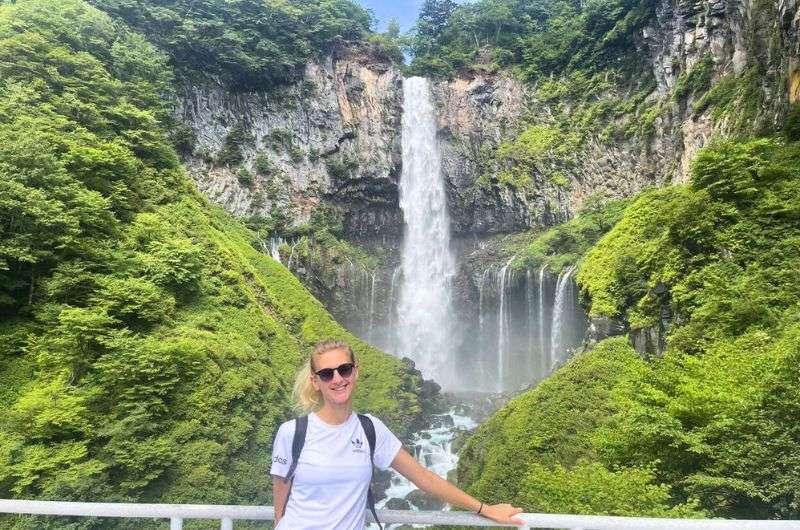
Kegon Falls
Alright, let’s talk about Kegon Falls—Nikko’s poster child for "waterfalls so pretty they'll make you want to weep." Plunging a dramatic 90 m (295 ft) into the depths below, it's a spectacle of roaring beauty. The best part? It's totally free to admire from the main viewing platform, but don’t stop there!
Kegon Falls isn't just about the drop. The fact that it flows directly from Lake Chuzenji adds a layer of awe to the scenery. The gorge itself looks like something out of a high-budget fantasy flick. You can soak up all the views in about 1.5 hours, which is perfect for those of us who have a low patience threshold and a packed 2-day itinerary in Nikko ahead of them.
Now, for a measly JPY 540 (about USD 3.50), you can hop on an elevator down to the lower observation deck. Do NOT skip this part. From the lower Kegon Falls observation area, the falls hit you from a whole new angle, making that few bucks spent feel like chump change for the value.
Impressed in Japan: Let me tell you, the infrastructure Japan whips up for their natural attractions? Mind-blowing. It’s like they’ve mastered the art of enhancing nature without messing it up, taking a completely different approach to natural attractions in Europe especially—take the "Tunnel of Light" in Kiyotsu Gorge as another wild example.
Built way back in 1930, the observation area at Kegon Falls has three levels, with the bottom deck offering the primo view. Seriously, the lower you go, the better it gets. And if you peek just right from the bottom deck, you’ll catch the secondary waterfall that's big and burly, just casually hanging out beside the main event, but being just as impressive.
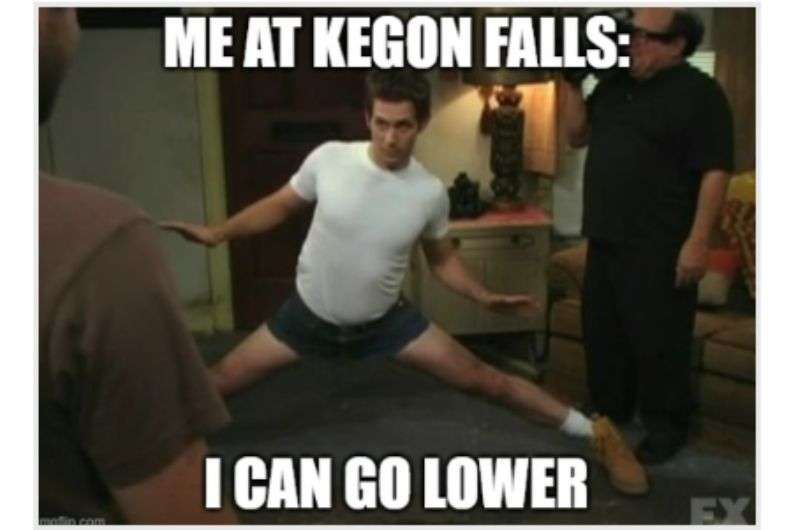
Tip: If heights are more your thing, check out the nearby Akechidaira Ropeway Observation Deck that offers a bird's-eye view of the watery beast that Kegon Falls is (though realistically, once you’ve been to Iguazu Falls, everything is just a trickle in comparison). The angle from which you view Kegon Falls from the ropeway—i.e. straight on with the lake behind it—makes it look like somebody left Lake Chuzenji’s faucet on. Don’t miss it!
3. Toshogu Shrine
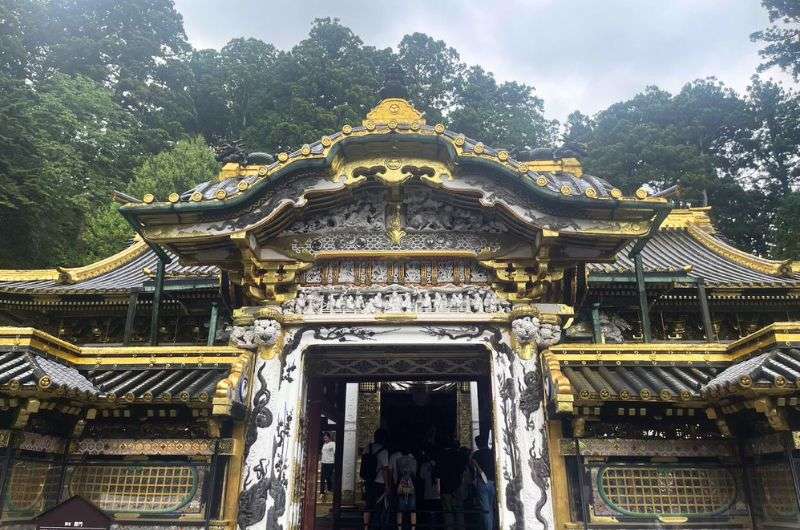
The fancy-pants details at Toshogu Shrine
Get ready to dive into the heart of Japan’s shogunate history at the Toshogu Shrine, the lavish final resting place of Tokugawa Ieyasu, the first shogun of the Tokugawa dynasty. It didn’t quite make it onto my list of Japan’s top temples and shrines, but not because I didn't love it—I really did—but because I classed it as a mausoleum (honestly it’s probably better than almost all of the shrines and temples I visited!). But it made UNESCO’s list! That’s pretty good, right? As a consolation prize, I mean.
My tip? Hit this spot early in the morning. Trust me, by midday, the lines swell to epic proportions, and it can feel like you’re sharing the space with a million others. For some, that’s a deal breaker. Like, I actually saw people leave.
The White Gate, or Yomeimon Gate, is probably the most extravagant gate in Japan, maybe even giving the Pearly Gates to heaven a run for their money, haha. It’s an architectural marvel, decked out with intricate carvings and decorations that will make you stop in your tracks and stare to take it all in. It’s not dark or red as is the norm at shrines in Japan, instead decked out in white and gold. But as with anything this grand, it attracts the crowds. Lines, lines everywhere, which can kinda kill the vibe if you're not prepared for it (and in my case, even if you are).
If you’re game for a workout, trekking up to Tokugawa Ieyasu’s mausoleum is a must—but fair warning, it involves quite a hike up a mountain of stairs. Along the way, the lush greenery really adds to the drama of the place.
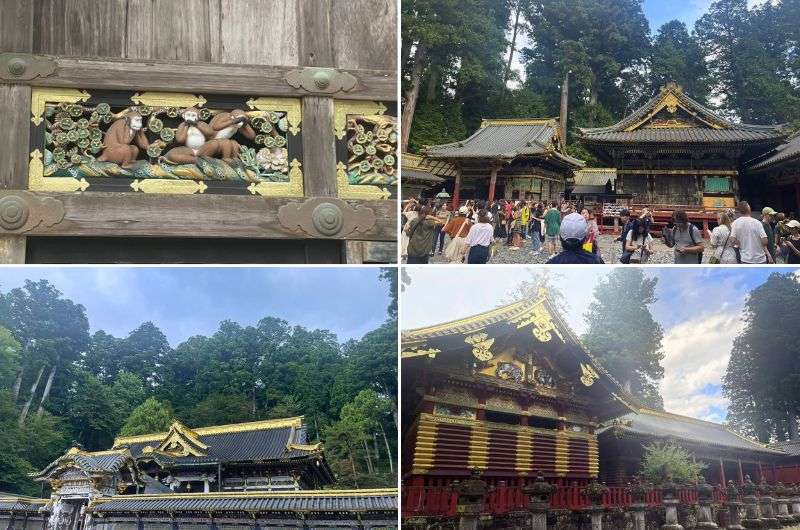
Notice the "See no evil, speak no evil, hear no evil" monkey carvings @ Toshogu Shrine
I loved the trees here and I’d climb those stairs again just to see them… especially since Toshogu’s main hall, while architecturally impressive, was a letdown on the inside. The experience involves walking around with a Japanese-speaking guide, with next to nothing to look at, all the while you’re in your socks, and so is everyone else—yes, even when it’s scorching outside, which can feel a bit... well, unhygienic and smelly.
Toshogu is also home to the iconic "See no evil, speak no evil, hear no evil" monkey carvings. These three wise monkeys are a cultural gem, embodying a key piece of Japanese folklore right in the fabric of this sacred site.
Overall, despite the potential for crowds and some less-than-stellar indoor experiences, Toshogu Shrine’s grandeur and rich history make it a must-visit in Nikko. Just maybe pack some hand sanitizer (and foot sanitizer needs to be a things in Japan, too!) and extra patience for those lines. If you’re ready to visit, see my Nikko itinerary.
4. Lake Yunoko & Yudaki Falls
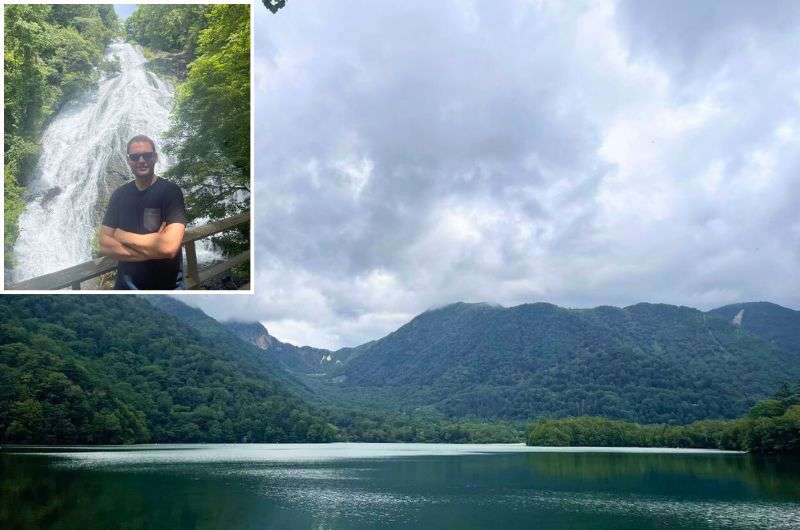
One minute you’re exploring Yudaki Falls under a blue sky and the next you’re at Lake Yunoko under a fluffy cloud blanket
Lake Yunoko and Yudaki Falls are where it’s at if you’re craving a bit of wilderness with a side of sulfur. Yudaki Falls, standing tall at 75 m (246 ft) and stretching 25 m (82 ft) across, isn’t just a waterfall—it’s an all-out nature blast that looks more like a ski slope than a trickle of water. Imagine a billion dragonflies buzzing around and you’ve pretty much got the vibe.
The area around the falls offers a small but mighty hiking loop that’s a total treat for those who like their nature walks with a little extra thrill. Loved the walk myself, but keep your eyes peeled—there are bear sighting warnings around, and while we didn’t bump into any furry friends, remember that a bear bell isn’t just a fashion statement here in Japan. On the flip side, we did spot some monkeys in the trees.
Getting to the top view of the falls involves a bit of a trek, and honestly, it’s kinda tiring and also a little boring. The view from up high was just so-so for me, but the lower level offers a much more impressive perspective of this powerful waterfall.
Next, brace yourself for a bit of a descent because from the falls to Lake Yunoko it’s a 100-meter (328 ft) elevation difference over just half a kilometer (0.3 miles)—hope you like stairs! Lake Yunoko itself, born from volcanic origins (it formed when lava from Mt. Mitsudake dammed the Yukawa River) means you get that classic sulfur smell—so it's like the whole place is giving you a big ol' eggy welcome. But trust me, the views around the lake are worth a sniff or two.
Tip: Speaking of volcanos and eggs, we ran into a cheap fountain of youth on Owakaduni, a volcano close to Mt. Fuji. You can buy black eggs (eggs turned black by the iron and sulfur in the water they are cooked in) that extend your life by 7 years per egg! Sure they smell like eggs, but you’re eating an egg, so…
Circumnavigating Yunoko lake takes about an hour, and it’s a chill walk with scenery that’ll make your heart skip a beat. Fancy a paddle? You can rent a paddleboard or even take a dip if you’re feeling brave and sweaty.
And if you’ve got wheels (which, if you’re a savvy Nikko explorer, you definitely should), Lake Yunoko is a quieter alternative to the bustling Lake Chuzenji. Less crowd, more nature—what’s not to love?
P.S. There are great walking trails leading from Yudaki Falls to Ryuzu Falls through Sensojagahara grassy plains. We didn’t go this time, but hey, as your go-to travel dude, I figured you’d appreciate the heads-up. I’ll be talking more about Ryuzu Falls later, but just so you know, we took the car there—because seriously, so much to see, so little time!
5. Rin’nōji Taiyū-in Mausoleum
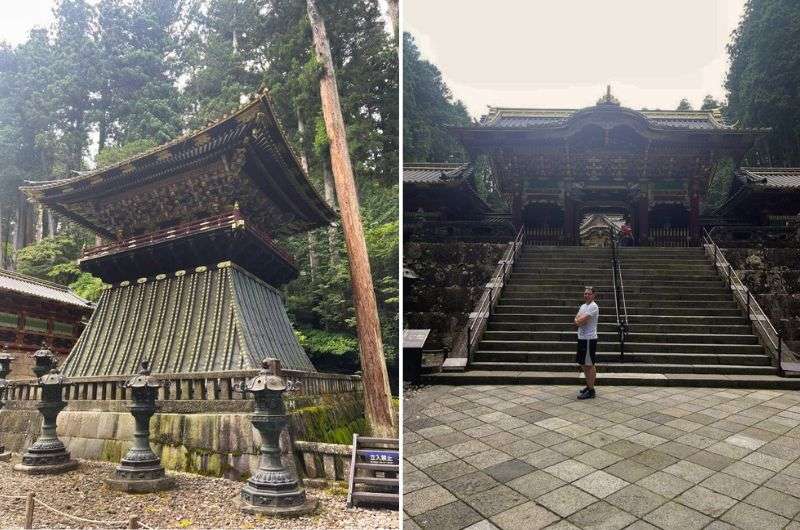
Exploring Rin’nōji Taiyū-in
Next up on the list of Nikko attractions? Rin’nōji Taiyū-in. Nestled among towering cedars, the path between the Taiyū-in Mausoleum and Rin’nōji main hall (more about it in the next item on this list) feels like stepping into another time—majestic and kind of magical.
Fun fact: Let’s get a bit historical here. Taiyū-in is the mausoleum of Tokugawa Iemitsu, the third Tokugawa shogun, and, fun fact, the grandson of Tokugawa Ieyasu, the founder of the Tokugawa Shogunate. Want to talk about family goals? Iemitsu not only renovated the Toshogu Shrine (see above) but also had Taiyū-in built facing Toshogu, just to keep things in the family.
Entry to the whole shebang is only JPY 500, which is a steal considering the spectacle. The journey up to the mausoleum is guarded by several imposing gates that remind me of Incan foundations from Peru—think massive, sturdy, and just awe-inspiring. The guards on these gates get progressively more decked out in armor, which is a cool little detail if you're into your battle gear (like me).
After a bit of a climb past a bunch of large lanterns with just the right amount of moss covering parts of the stairway, you hit the mausoleum at the top. It’s lavishly designed, and yes, you’ll need to ditch your shoes again (I never imagined some of my strongest memories of Japanese temples and shrines to be so… olfactory). Inside, sit back, relax, and soak in the history (and smell) as a guide talks about this impressive building.
The courtyard of the mausoleum itself is nothing short of stunning. It features drum towers used to mark the time of day, much like bell towers in European churches—but, you know, without Jesus. The fact that it's all wooden architecture makes it feel both monumental and cozy at the same time.
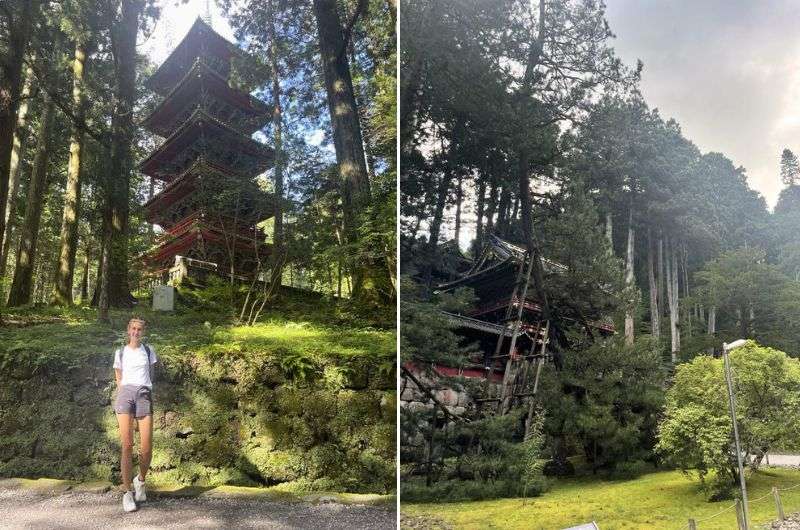
The pagoda and the buildings near the mausoleum are hidden in the dense forrest
I noticed how some of the structures are made of concrete instead of the original wood. What’s up with that? Laziness? Funds? Or maybe just a shrug-your-shoulders kind of "Japan" moment?
A standout on the approach to Rin’nōji Taiyū-in is the gorgeous five-story pagoda that blends seamlessly into the forest backdrop. It’s a perfect example of how architecture here is meant to complement rather than compete with nature. Mission completed if I say so myself.
Rin’nōji Taiyū-in is nestled among other spiritual stunners, including the nearby Toshogu Shrine and Futarasan Shrine, both of which made this “top things to do in Nikko” list, making this area a cluster of cultural and historical richness. If you're hitting up Nikko, weaving through these spots offers a deep dive into the soul of Japan's past—and it’s fascinating. Though, I have to admit, temple burnout is real in Japan, so pace yourself!
6. Nikkozan Rin’nōji Temple
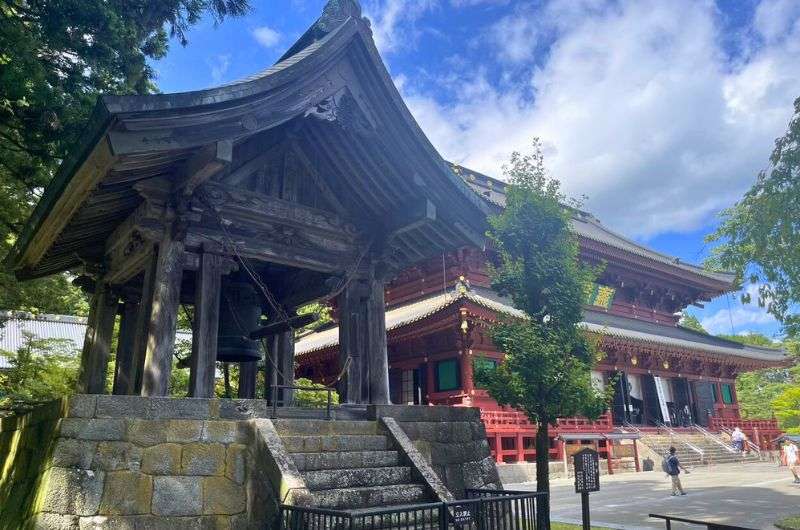
The bell and its little house at Nikkozan Rinnoji Temple
So, Nikkozan Rin’nōji Temple, let’s get straight to the point: this place is an absolute behemoth of a wooden structure that grabs your attention from miles away. It sticks out like a sore thumb, but in a good way.
Annoyance warning: When you try to take a photo, expect to spend at least 10 minutes getting that perfect shot, because it seems like there’s a trillion people (cough *Indians* cough) milling about who just don’t get that you don’t want them in your frame. Trying to get a photo without a tourist popping their head in feels like playing Whac-A-Mole with a camera—every time you aim, someone pops up! I’d have to be Buddha to stay patient, so let’s say I was a little over it by the 4th minute. (Oh, stop being offended. Indians, you know it’s true!)
Right in front of the temple, there’s this 600-year-old cherry tree. Yeah, it’s just a big ol’ cherry tree. Honestly, cherry blossoms aren't really my thing—I'm more of a cedar guy. But hey, credit where it’s due, it’s a pretty impressive old tree.
Next to the Main Hall, there’s a gorgeous bell set among the cedars. I mean, would I like it as much if it were surrounded by cherry blossoms? Doubtful. The main hall looks just okay from the inside, but like many Japanese temples and shrines, it’s the outside that really wows you. To me, the bell outshines the Main Hall.
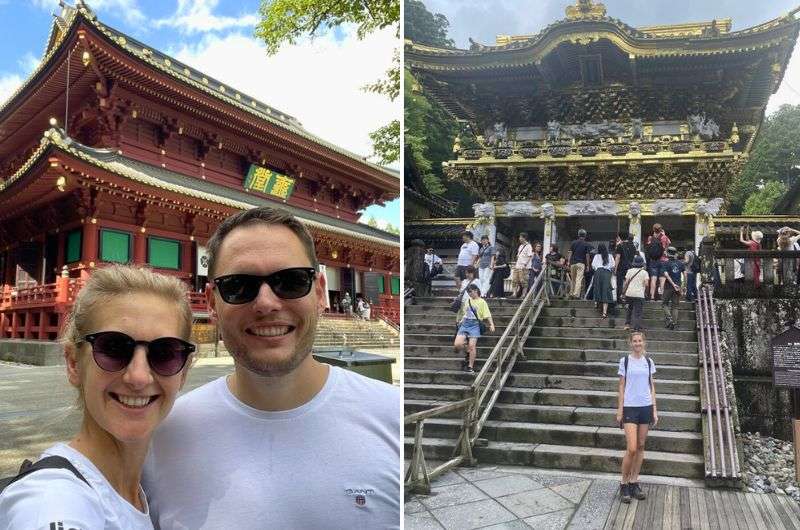
Rinnoji temple was impressive (from the outside), massive, and smelled surprisingly nice (from the inside)
Rin’nōji Main Hall is a history buff’s dream, but everything's written in Japanese! Like, are you serious? For a country that sees some 32 million international tourists a year, that feels like a massive oversight, or a smack in the face to tourists (and not the good kind that you get from the nature around Nikko).
Inside Nikkozan Rin’nōji Temple, it actually smells nice—like, really nice. A refreshing change from the usual foot odor you brace for. Behind the golden pillars of the Main Hall, there's this giant path lined with cedars that seriously impressed me (seriously, what is my deal with cedars?!). It would be even better minus the 1000 people crowding it.
Overall, Nikko seriously reminds me of California’s Redwoods National Park, thanks to all those cedar forests. The nature here isn't like what you find in Europe; it's a whole different vibe that I really dig.
7. Ryuzu Falls
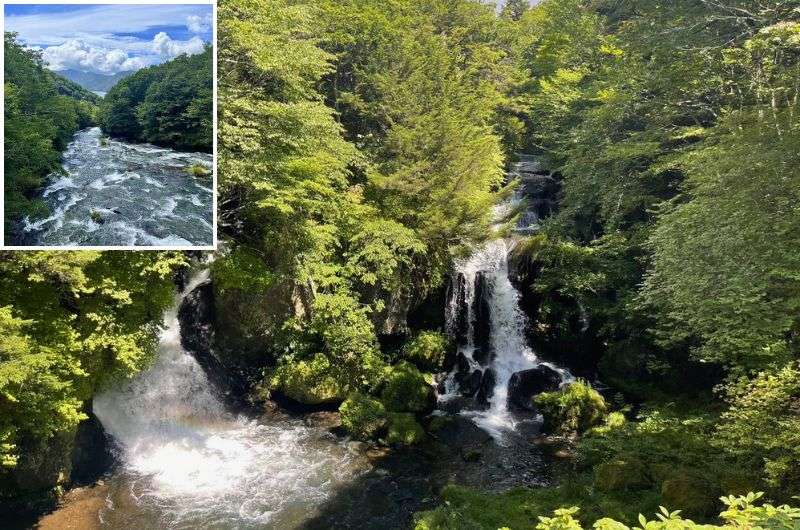
Checking out Ryuzu Falls
Ryuzu Falls (aka “Dragon Head Falls”) might not pack the same punch as Kegon Falls, but don't write it off just yet. This cascade, often depicted as a dragon splitting into twin streams at the bottom, offers a scenic alternative that's still absolutely worth the visit for its views. Plus, there's a conveniently large parking lot right nearby (both at the top and bottom levels), making access easy.
Imagine trekking alongside a dragon-shaped waterfall—yeah, that’s Ryuzu for you (granted, you need a lot of imagination to make it a dragon). Be ready to conquer a bunch of stairs trailing the entire length of the dragon (it’s only about 200 m, i.e. 0.1 mi one way), with relentless views of the water to keep you company. Sure, the falls themselves might not scream 'epic,' but the lovely vistas from this spot more than make up for it.
And here’s a little tip: there’s a viewing platform that's part of a café right next to the falls—it's the prime viewing spot of the dragon’s head. You can enjoy direct views while sipping something warm or cold, sitting comfortably with tables and chairs placed against large windows. It’s the perfect spot to take a break without stepping away from the comfort of a good seat—they’re wooden benches ok?
If you're up for a bit of a walk, you can hit a super-easy trail leading all the way from Yudaki Falls to Ryuzu Falls through Sensojagahara grassy plains (more on Sensojagahara below). Stretching about 5.5 km (about 3.4 mi), it’s an ideal way to experience more of Nikko’s natural beauty at a leisurely pace, all the while walking on wooden walkways raised above the marshland.
8. Nikko Futarasan Shrine
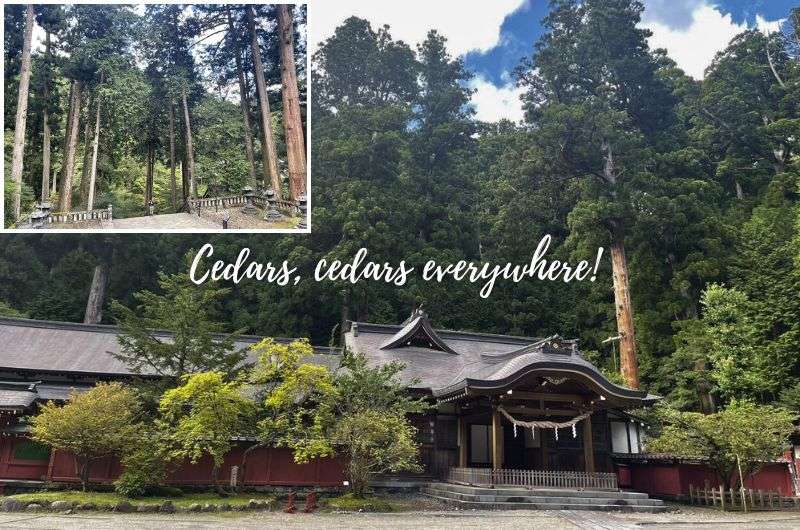
Tucked right in the heart of Nikko, alongside heavy hitters like Rinnoji Temple and the Toshogu Shrine, Futarasan Jinja is part of the iconic trio making up the Shrines and Temples of Nikko UNESCO World Heritage Site. If you’re whipping out your map, you'll see it cozying up close to these other legends.
You can really see how the Japanese have reverence for the gods. Visitors bowing here, there, and everywhere—it’s like a full-on back exercise routine. They’ve got to bow like 80x a day!
Nikko Futarasan Shrine is a cornerstone of Shinto belief with over 1,200 years of history in its pocket. Founded in 782 by Shodo Shonin, the man who basically brought Buddhism to Nikko, this shrine predates its more flamboyant neighbor Toshogu. It’s dedicated to the deities of Nikko's sacred mountains—Mount Nantai, Mount Nyoho, and Mount Taro. Fun fact: "Futarasan" is another name for Mount Nantai, the VIP of this mountainous trio.
Walking into the shrine is free, but it’ll cost you a few yen (JPY 250–550) to peek inside certain buildings. Around here, you might notice plenty of those 'golden Easter bunnies' as my girlfriend calls them, or as they’re actually known, Japanese forest spirits. Feel free to drop a donation; it's good shrine karma.
Tip: If you’re worried you’ll make a fool of yourself in front of the deities for not bowing, donating, and clapping correctly, check out my shrine and temple etiquette guide.
A kilometer away from the shrine, you’ll also find Shinkyo Bridge, but more about that in item no. 12 on this list. It’s a stunner!
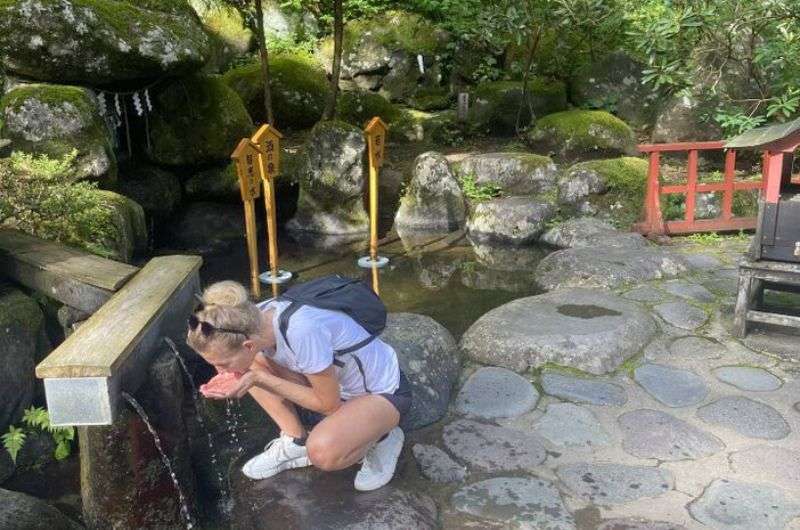
You can also just skip the special “spring” coffee and drink the water directly from the spring. I’m sure it’s more magical that way anyway
The shrine interiors are, well, let's just say it's typical—you come for the exteriors. The interiors aren't much to write home about, which is pretty standard for Japanese shrines in my experience. However, there are a couple of swords there that are national treasures, which are genuinely worth a 10-second stop.
The information posted reminded me of what it’s like sightseeing in Peru, where every sign tells you the same three things: Nikko was founded by Shodo Shonin, it’s really old, and yes, it’s important. So now, you don’t need to read any plaques when you visit—you’re all set. You’re welcome.
Tip: Check out the little shack behind the Haiden of Futarasan Shrine. They serve tea and coffee made with water from the sacred spring. It might not promise the longevity of Owakudani's black eggs, but hey, who knows? Maybe we can test its life-extending powers and have a reunion here in 80 years to see if the magic worked!
9. Senjōgahara Marshlands
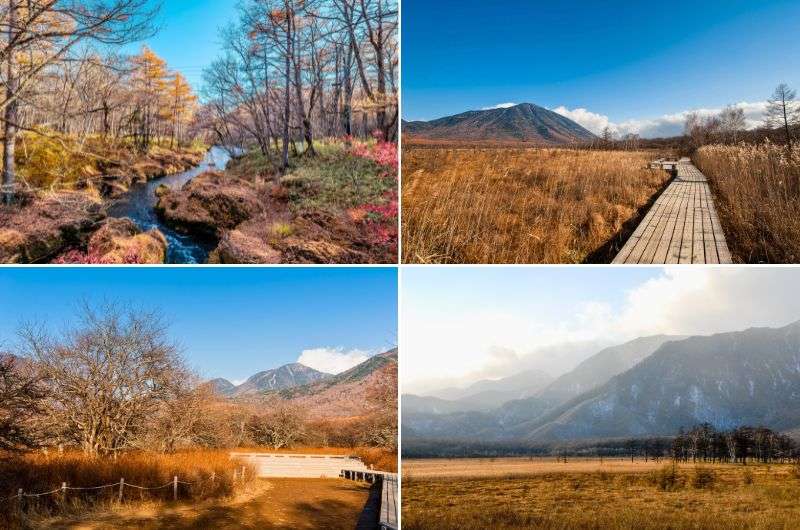
Japan’s not all about the pink flowers blooming on cherry trees! Check out Senjōgahara marshland dressed in fall colors
Fans of raised wooden trails, rejoice! Have I got a gem for you. You can live out all your walkway dreams in the grassy plains of Senjōgahara. Located between Yudaki and Ryuzu Falls, Senjōgahara marshland is a flat area that’s an ecological treasure trove showcasing yet another facet of Nikko’s natural beauty.
If you have a couple of hours to spare, why not take a leisurely walk through the area's several trails, most of which are along wooden walkways? You can stop at picnic tables for a snack, hit up all of the observation decks, and immerse yourself in the serenity. The plains are a paradise for birdwatchers and botany enthusiasts, with a variety of plants and birds to spot, and maybe even a deer or two if you're lucky. Plus, the mountain and river views are nothing short of spectacular, albeit a bit repetitive.
The trails are well-maintained and completely flat, making them accessible for visitors of all ages. However, be warned: Senjōgahara can resemble a little wooden highway on weekends and holidays due to its popularity. So, if you’re not a fan of crowds, you might want to plan your visit for a quieter time.
Alternatively, if you’re short on time or have no desire to walk, the main Senjōgahara Observation Deck is conveniently located right by the road, complete with a sizeable parking lot and a café. This is the place that has the best view directly over the grassy plains with the mountains in the background. But there’s no way to venture into the marshland from here.
For a slightly more immersive experience, consider parking a bit to the south at the Akanuma Nature Information Center. From there, you can easily cross the road and enter Senjōgahara. Within about 5 minutes of walking on the wooden walkways, you'll reach another observation deck, offering a quick yet satisfying glimpse into this ecosystem. This time, you’ll be walking along the forested area, seeing the grassy plains from the edge of the forest where the river flows.
10. Nikko Tamozawa Imperial Villa
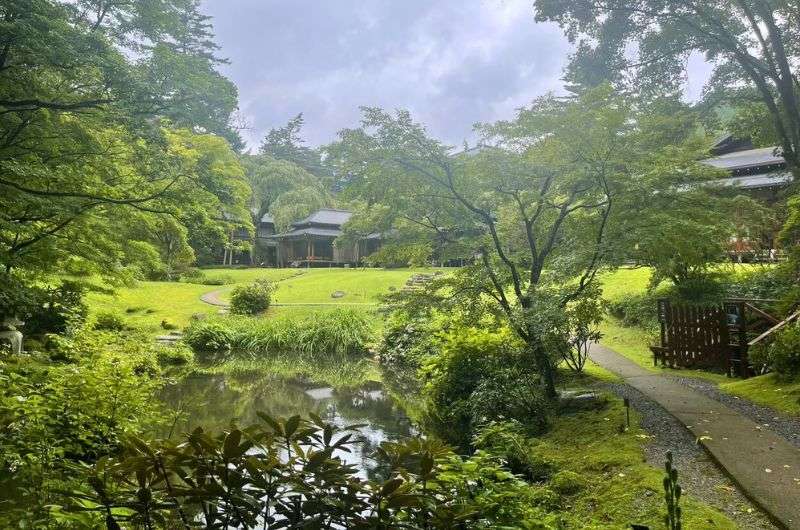
Not a bad place to spend a royal summer getaway
Now for an attraction that's right in Nikko town, the Imperial Villa. This serene spot is a grand estate that once served as the country retreat for two Japanese emperors. Like a really fancy, exclusive club house. Surprisingly, this place was way calmer and less crowded then most other must-see places around Nikko, so that's a huge bonus point from me.
Spanning an impressive 30,000 m2 (about 322,900 square feet), the villa is absolutely massive, echoing the luxury and spaciousness favored by the emperors (and myself) for relaxation. That's a lot of ground for emperors to unwind and probably plot their next garden party.
Nikko Tamozawa Imperial Villa is a place where beauty meets calm, with ultra-pretty settings that are perfect for strolling around in socks—just make sure to bring your nicest pair because my girlfriend didn’t realize she’d be showing off hers and was slightly embarrassed about the pair she donned that day. The carpets are nice, though, so there’s that.
Inside, you’re walking through room after room—there’s more than 100 of them—with pretty much nothing in them. I mean, it’s cool to wander through a palace and all, but after the third empty room, you kinda get the gist. The mix of Edo and Meiji architecture with bits of Western flair thrown in gives the place a unique vibe, but the lack of furnishings make it underwhelming. The Japanese really have such potential with these buildings, and yet they leave them boring. I don't get it.
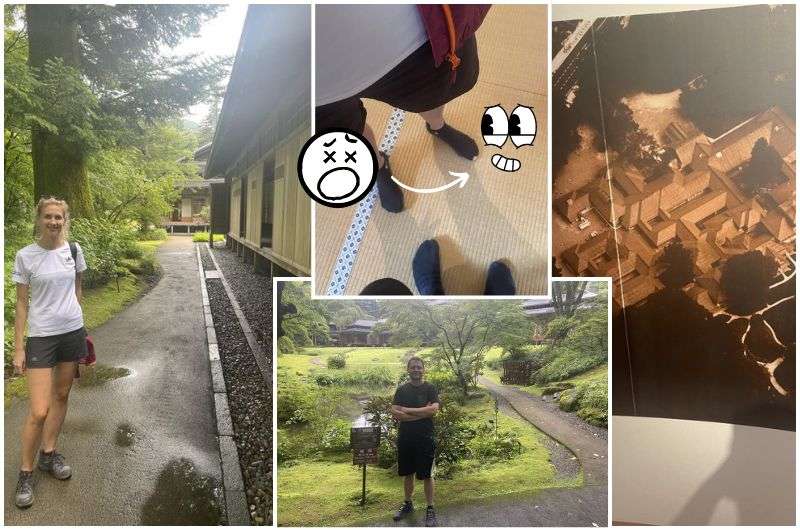
It’s all fun and games until you realize you decided to wear those holey socks one last time...
The gardens are where it’s at, though. They’ve got this laid-back, natural feel that’s just peaceful, and you can take a good look at the exterior of the very large villa. You can see why the emperors chose this spot for their summer retreat. Each summer, one of the former emperors would roll up here, and I can see why. The garden incorporates elements of formal Japanese garden design yet maintains a natural feel. It’s got that regal charm without trying too hard. Perfect for a royal escape, or just a regular Joe (or Jan) looking for a break from temple hopping.
You’ll need 30 minutes max for the interior and then however long you manage to keep yourself occupied in the Imperial Villa gardens.
11. Italian and British Embassy Villas
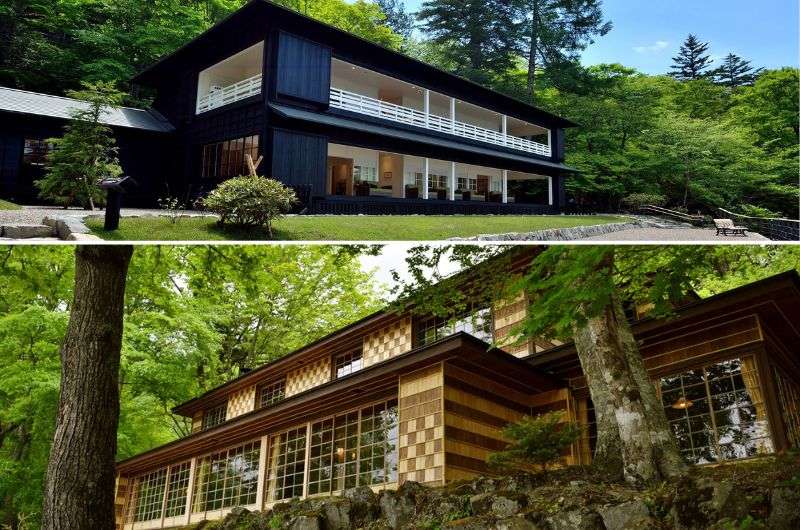
British Embassy Villa on top, Italian Embassy Villa on the bottom... two very different ladies. The British one is dark on the outside but brighter on the inside (details on www.nikko-nsm.co.jp/en/)
Next up on our tour of Nikko are the Italian and British Embassy Villas. Not your typical tourist attractions but stay with me—these places are where European flair meets Japanese precision, and it’s the perfect melding of the two styles and personalities. And they aren’t used as embassies anymore, so no worries about stumbling upon secret consular secrets.
Nestled in scenic spots right next to each other on the shore of Lake Chuzenji, they’ve got killer views and are1 open to the public to stroll around the grounds and interiors. Both spots boast incredible lake views but bring their own unique vibes to the table.
Let’s kick off with the British Villa: it's the clean-cut cousin in this international family. With a design that’s straightforward and bright, it’s all about the elegant simplicity here. You won't see Mount Nantai from this spot, nor will you find a beach, but you can get right up to the water for a serene view. Inside, there’s an exhibition explaining why Nikko was such a hit with foreign diplomats back in the day (can you blame them?).
Feeling a bit British? Grab some tea and take it upstairs to the terrace. It’s the perfect spot to gaze out over the lake and pretend to make some important diplomatic decisions.
Swinging over to the Italian Villa just a hop and a skip away, this place has more of a "grandma's cozy cottage" charm, if your grandma was into lush, old-world decor. The ambiance here is a tad darker than the British Villa; I wasn’t a fan really. While there's no formal exhibit, the helpful staff will fill you in on the villa’s historical and decorative nuances.
After learning a thing or two, you can chill with a cup of coffee from the café. Though the veranda isn’t open-air like the British terrace, the enclosed space with large windows still offers an inviting spot to sit back and try to figure out if the views are the same as next door.
Both villas showcase a neat blend of European elegance with subtle Japanese touches and they’re a fantastic way to experience a bit of Europe in Japan, without the crowds.
Visiting these spots won’t eat up much of your day either—it’s a quick hit of architecture and views, maxing out at about an hour for both. Perfect for when you want a dose of culture but have other sights to get to in Nikko.
12. Shinkyo Bridge
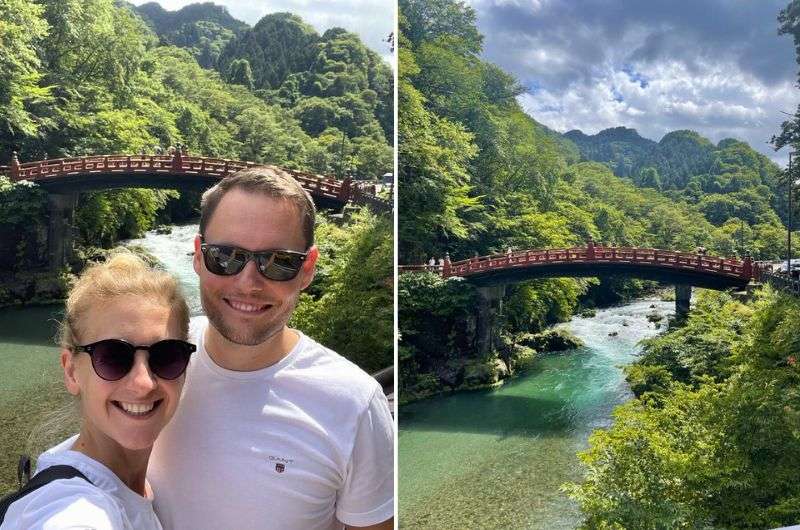
Look at us making the Shinkyo Bridge look good! What you can’t see it the busy road right in front of us
Just a 1 km (0.6 mi) stroll from the Futarasan Shrine, passing by Nikkozan Rin’nōji Temple, you'll bump into Shinkyo Bridge, which is still officially part of Futarasan Shrine's grounds. It's often touted as one of the top three prettiest bridges in Japan. I'm not the type to keep rankings or anything, but let me tell you, this bridge is a knockout with its vibrant red arches that elegantly leap over the Daiya River. Talk about a picture-perfect scene!
The lore behind Shinkyo is as colorful as the bridge itself. Legend has it that the head priest of the area needed a way to cross the river, so he called upon the mountain deities. In response, two snakes slithered up and transformed into this stunning crimson bridge. Pretty nifty divine intervention, if you ask me!
These days, though, you can't actually use it to cross the river. It'll cost you JPY 300 to set foot on it, but it’s a dead-end journey—you’ll have to double back and use the other bridge to actually get across.
Here’s a little heads up: Shinkyo Bridge closes around 5 pm. Then again, a closed bridge looks exactly the same as an open bridge, and a closed bridge without a crowd offers a clear shot for your photos, which isn't a bad deal at all. You're actually better off snapping pictures from the sidewalk or the more modern bridge right next to it anyway. After all, it would be quite the feat to get a good shot of the bridge while you’re standing on it!
13. Nikko Treasure House: A maybe-see
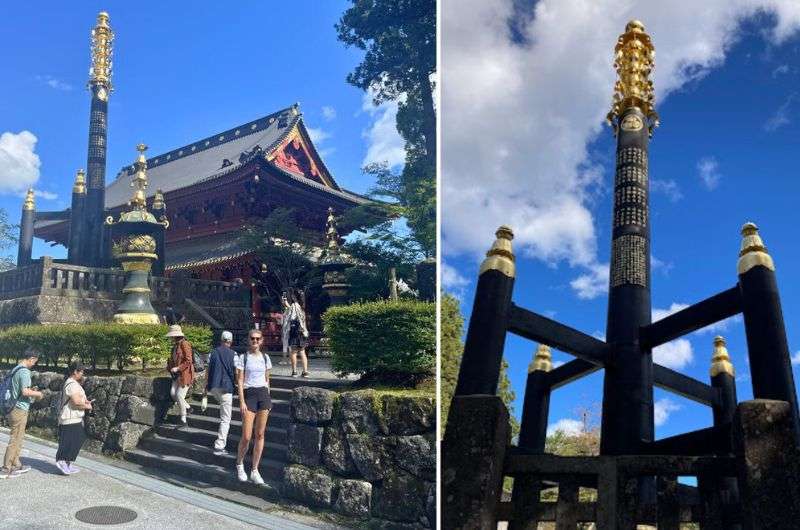
The only somewhat interesting Rin’nōji Treasure House
Wrapping up our Nikko tour, we swing by the Rin’nōji Treasure House, which, to be honest, is more of a 'maybe' on this must-see list. Located just opposite the main hall of Rinnoji Temple, this spot is part of the combo ticket that also gets you into the main hall and the Taiyuin Mausoleum. If it’s included in your ticket, why not check it out? But don't expect to be blown away.
Now, I'm all for getting the most bang for my buck, so we popped into the treasury since it was already on our pass. It’s okay—nothing to write home about, really. If you’re planning your time, and this isn’t included in a pass you’ve already bought, I’d say your yen might be better spent elsewhere.
The little garden outside the treasure house, though? Now, that was a quiet surprise. It turned out to be more interesting than the actual treasures inside. Sometimes, it’s the little things, right? If you find yourself at the treasury, make sure to give that garden some love—it’s a peaceful spot that deserves a moment or two.
And that’s all folks, my list of places to see in Nikko. Looking over it, it’s a lot of nature mixed in with a good number of temples and shrines, which is what you’ll be getting most of in Japan, but in Nikko, it’s somehow magnified and truly fascinating. If you’re ready to take the leap, head over to my Nikko itinerary for 2 days, or, if you like things served to you on a silver platter, why not get my full Japan itinerary. Nikko’s on there, too, obviously. You can’t skip Japan’s best destination!
FAQ 1: How to get to Nikko from Tokyo?
Getting to Nikko from Tokyo is a breeze with a few convenient options. The fastest way is to hop on the Tobu Railway from Asakusa Station; it’ll whisk you to Nikko in about two hours. If you’re holding a JR pass, you can catch the JR Tohoku Shinkansen from Tokyo Station to Utsunomiya Station, then switch to the JR Nikko Line, which gets you there in roughly the same time. Either way, you’re set for a smooth ride with some scenic views to boot.
FAQ 2: Is Nikko walkable?
Nikko is quite walkable in the central area around the shrines and temples, but you’ll need a car to get to most of the natural highlights surrounding it. Many of Nikko's main attractions, like the Toshogu Shrine and Shinkyo Bridge, are located close together, making it easy to explore on foot. For sights spread farther apart, such as Lake Chuzenji and Kegon Falls, you will want to consider other transport options—buses will work but are not an effective way to spend your time, so, as always, I vote rental car.
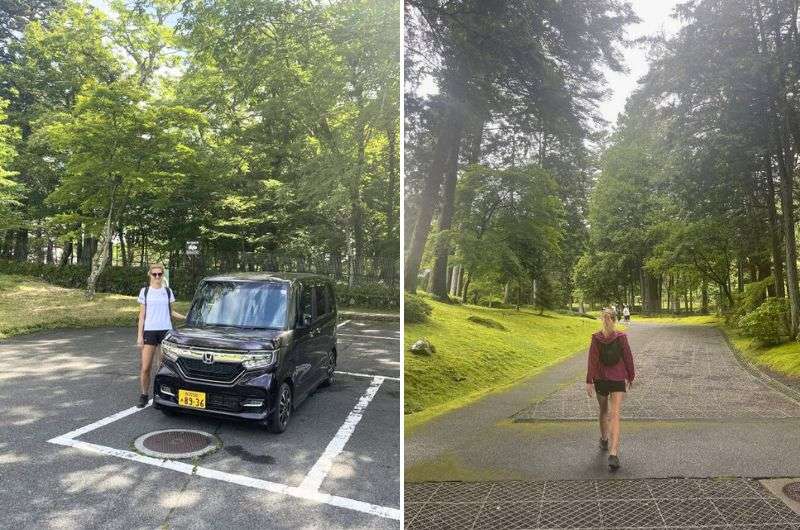
You’ll be doing yourself a favor if you rent a car in Nikko, it’s so much easier to get around to all the hotspots
FAQ 3: Is Nikko Japan worth visiting?
Absolutely, Nikko is definitely worth visiting—it was my favorite place in Japan! It's a stunning blend of natural beauty, history, and culture. From the majestic waterfalls and scenic hiking trails to the ornate shrines and tranquil temples set among the cedar groves, Nikko offers an experience that's hard to match. I’d say it’s the perfect escape, especially if you appreciate the great outdoors and historical sites, but that insinuates you’ll be escaping the crowds, and that would be a lie. EVERYONE wants to see Nikko.
FAQ 4: Is Nikko line covered by JR Pass?
Yes, the JR Nikko Line is covered by the JR Pass. This line operates between Utsunomiya Station and JR Nikko Station, with all trains on this line being local services that stop at all stations. So, if you have a JR Pass, you can hop on and off along this route without any additional cost.
FAQ 5: What is the main attraction of Nikko?
The main attraction of Nikko is Toshogu Shrine, a lavishly decorated shrine complex that serves as the mausoleum of Tokugawa Ieyasu, the founder of the Tokugawa shogunate. It's famous for its intricate carvings, including the renowned "See no evil, speak no evil, hear no evil" monkey carvings, and its stunning architecture. Not to mention Yomeimon Gate, which is probably the most extravagant gate in Japan. This UNESCO World Heritage site draws visitors from around the world and is a must-see when in Nikko.
This post contains affiliate links. I earn a small commission if you make bookings through my links, at no additional cost to you. Thank you for your support!
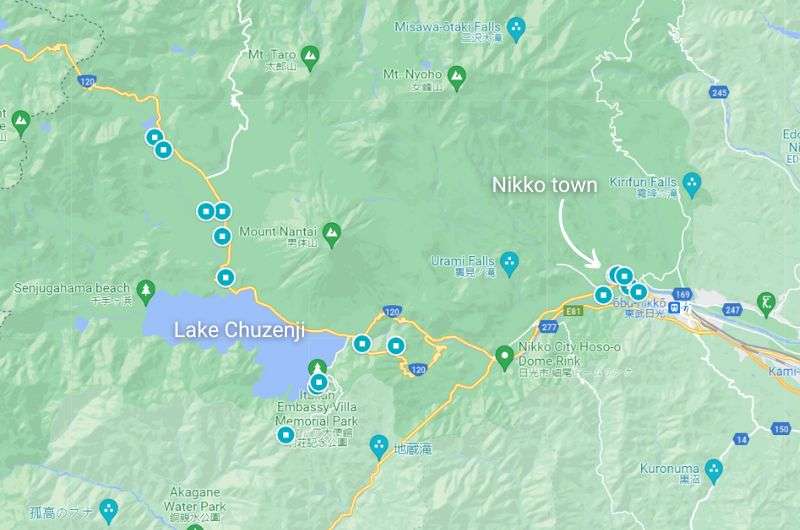
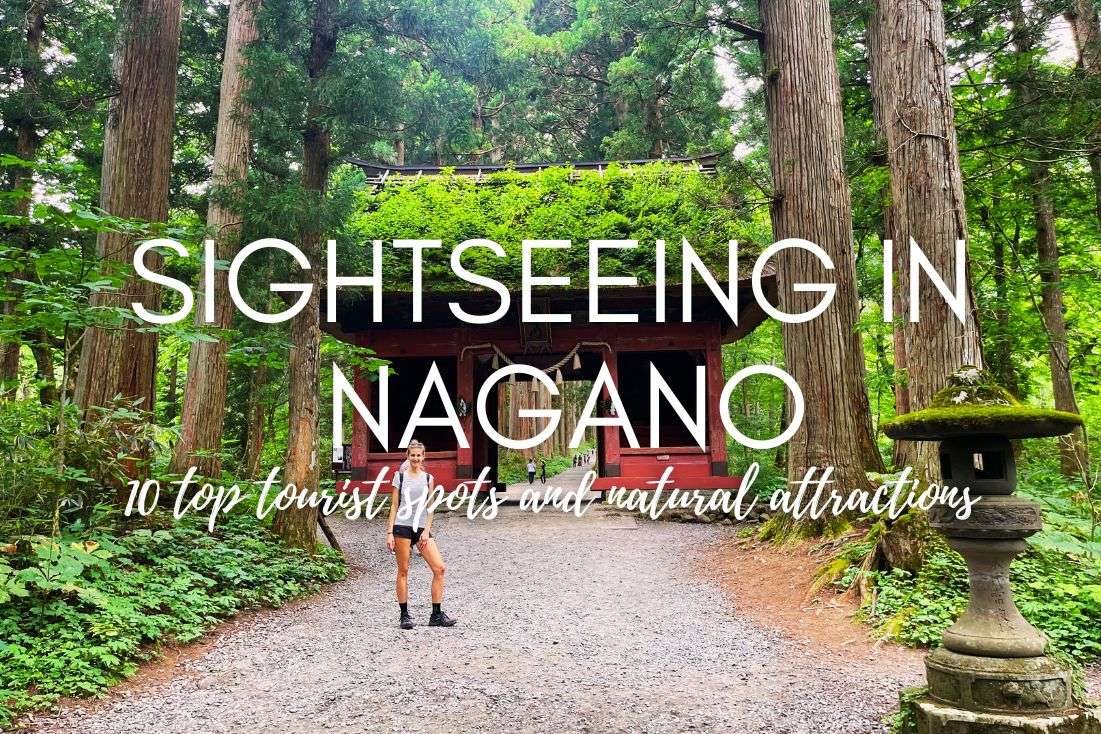
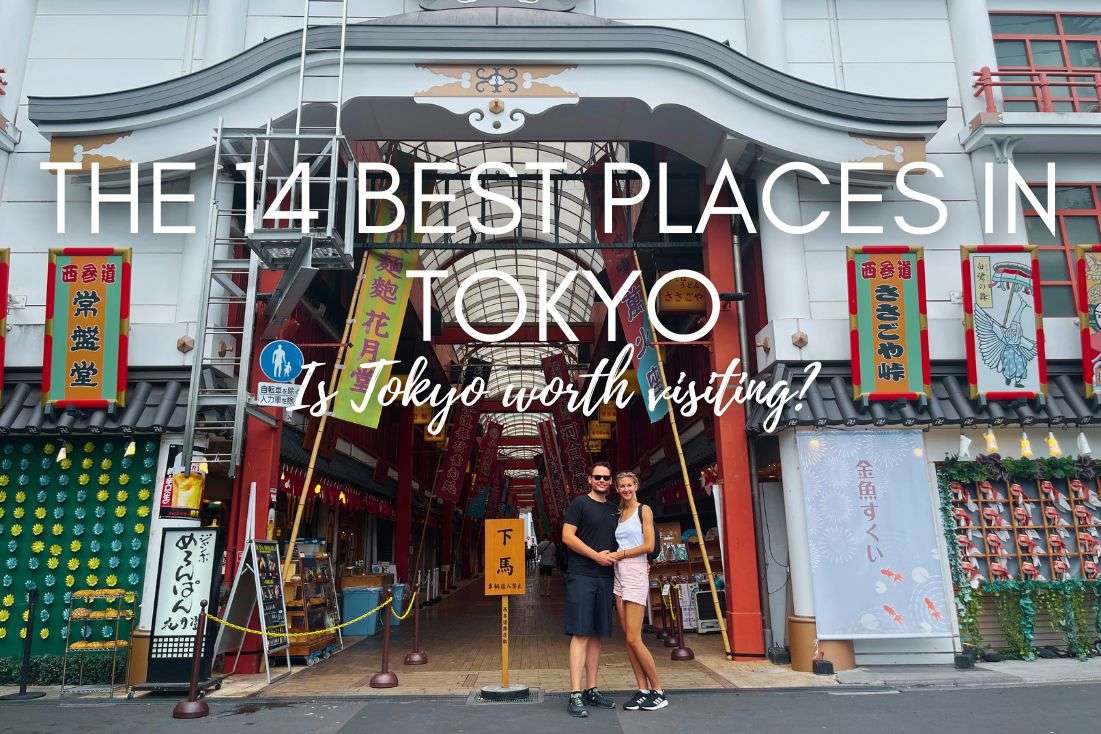




Comments
Thoughts? Give us a shout!